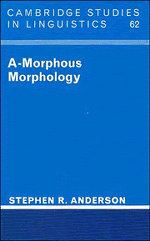Book contents
- Frontmatter
- Contents
- Acknowledgments
- Introduction
- 1 The study of word structure
- 2 Why have a morphology at all?
- 3 Is morphology really about morphemes?
- 4 The interaction of morphology and syntax
- 5 The theory of inflection
- 6 Some complex inflectional systems
- 7 Morphology in the lexicon: derivation
- 8 Clitics are phrasal affixes
- 9 The relation of morphology to phonology
- 10 How much structure do words have?
- 11 Composites: words with internal structure
- 12 Morphology and the typology of languages
- 13 Morphological change
- 14 Morphology as a computational problem
- References
- Index
5 - The theory of inflection
Published online by Cambridge University Press: 10 January 2011
- Frontmatter
- Contents
- Acknowledgments
- Introduction
- 1 The study of word structure
- 2 Why have a morphology at all?
- 3 Is morphology really about morphemes?
- 4 The interaction of morphology and syntax
- 5 The theory of inflection
- 6 Some complex inflectional systems
- 7 Morphology in the lexicon: derivation
- 8 Clitics are phrasal affixes
- 9 The relation of morphology to phonology
- 10 How much structure do words have?
- 11 Composites: words with internal structure
- 12 Morphology and the typology of languages
- 13 Morphological change
- 14 Morphology as a computational problem
- References
- Index
Summary
In chapter 4 we discussed some reasons to believe that ‘inflection’ is a domain of grammar in which morphological and syntactic considerations overlap to a significant extent. In section 4.2 of that chapter, we dealt with one central aspect of a theory of that domain: the content and nature of Morphosyntactic Representations. The point of that exercise was not simply to develop a (possibly obscure) formalism, but rather to explore just exactly what information exists in the interface between syntax and word structure. We saw that this can be reduced to an unordered list of inflectional properties (or ‘morphosyntactic features’), with a minimum of internal structure. A limited internal organization of this information, beyond that of an unordered inventory of properties, is necessary to deal with cases where a single word bears more than one specification for the same dimension. To accommodate these, we proposed the device of ‘layered’ representations (essentially, the hierarchical subordination of some unordered feature sets to others), together with a general convention on how these are created and a restricted set of ways in which their content can be referred to in specific rules.
Recall that in chapter 4 we found a number of substantive areas where morphological properties of words appear to be determined by an interaction with the syntactic environments in which they appear; or of properties that must be visible to syntactic principles for these to perform their intended function.
- Type
- Chapter
- Information
- A-Morphous Morphology , pp. 102 - 135Publisher: Cambridge University PressPrint publication year: 1992



